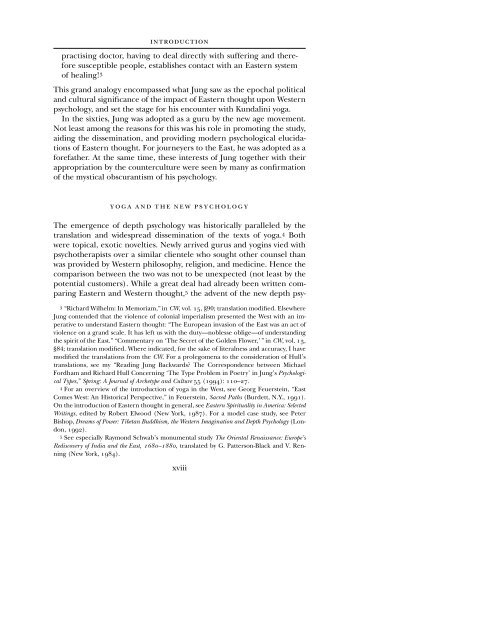CG JUNG - Countryside Anarchist
CG JUNG - Countryside Anarchist
CG JUNG - Countryside Anarchist
You also want an ePaper? Increase the reach of your titles
YUMPU automatically turns print PDFs into web optimized ePapers that Google loves.
INTRODUCTION<br />
practising doctor, having to deal directly with suffering and therefore<br />
susceptible people, establishes contact with an Eastern system<br />
of healing! 3<br />
This grand analogy encompassed what Jung saw as the epochal political<br />
and cultural significance of the impact of Eastern thought upon Western<br />
psychology, and set the stage for his encounter with Kundalini yoga.<br />
In the sixties, Jung was adopted as a guru by the new age movement.<br />
Not least among the reasons for this was his role in promoting the study,<br />
aiding the dissemination, and providing modern psychological elucidations<br />
of Eastern thought. For journeyers to the East, he was adopted as a<br />
forefather. At the same time, these interests of Jung together with their<br />
appropriation by the counterculture were seen by many as confirmation<br />
of the mystical obscurantism of his psychology.<br />
YOGA AND THE NEW PSYCHOLOGY<br />
The emergence of depth psychology was historically paralleled by the<br />
translation and widespread dissemination of the texts of yoga. 4 Both<br />
were topical, exotic novelties. Newly arrived gurus and yogins vied with<br />
psychotherapists over a similar clientele who sought other counsel than<br />
was provided by Western philosophy, religion, and medicine. Hence the<br />
comparison between the two was not to be unexpected (not least by the<br />
potential customers). While a great deal had already been written comparing<br />
Eastern and Western thought, 5 the advent of the new depth psy-<br />
3 “Richard Wilhelm: In Memoriam,” in CW, vol. 15, §90; translation modified. Elsewhere<br />
Jung contended that the violence of colonial imperialism presented the West with an imperative<br />
to understand Eastern thought: “The European invasion of the East was an act of<br />
violence on a grand scale. It has left us with the duty—noblesse oblige—of understanding<br />
the spirit of the East.” “Commentary on ‘The Secret of the Golden Flower,’” in CW, vol. 13,<br />
§84; translation modified. Where indicated, for the sake of literalness and accuracy, I have<br />
modified the translations from the CW. For a prolegomena to the consideration of Hull’s<br />
translations, see my “Reading Jung Backwards? The Correspondence between Michael<br />
Fordham and Richard Hull Concerning ‘The Type Problem in Poetry’ in Jung’s Psychological<br />
Types,” Spring: A Journal of Archetype and Culture 55 (1994): 110–27.<br />
4 For an overview of the introduction of yoga in the West, see Georg Feuerstein, “East<br />
Comes West: An Historical Perspective,” in Feuerstein, Sacred Paths (Burdett, N.Y., 1991).<br />
On the introduction of Eastern thought in general, see Eastern Spirituality in America: Selected<br />
Writings, edited by Robert Elwood (New York, 1987). For a model case study, see Peter<br />
Bishop, Dreams of Power: Tibetan Buddhism, the Western Imagination and Depth Psychology (London,<br />
1992).<br />
5 See especially Raymond Schwab’s monumental study The Oriental Renaissance: Europe’s<br />
Rediscovery of India and the East, 1680–1880, translated by G. Patterson-Black and V. Renning<br />
(New York, 1984).<br />
xviii


